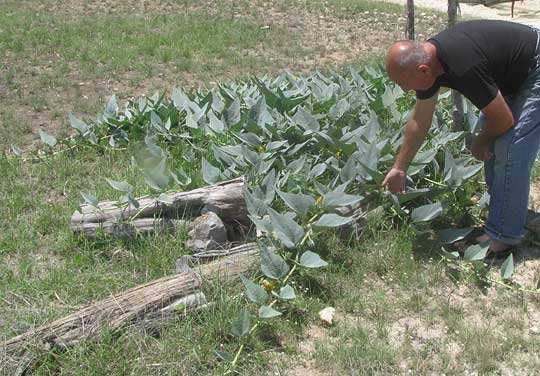Excerpts from Jim Conrad's
Naturalist Newsletter

from the June 16, 2013 Newsletter issued from the valley of the Dry Frio River in northern Uvalde County, southwestern Texas, on the southern border of the Edwards Plateau; elevation ~1750m (~5750 ft); N29.62°, W99.86°; USA
STINKING GOURD
My neighbor Phred told me about a strange vine near his house that each year issues long stems across the ground, It produces large, yellow flowers like a watermelon or winter squash vine, but its leaves aren't like either of those, and its fruit, while a little similar to a watermelon, never gets much bigger than a softball. I'd never heard of such a thing so we went to take a look. Below you can see Phred feeling a leaf's rough surface:

A close-up showing a tough, musky-smelling, sandpaper-surfaced, crooked-based leaf with a half-mature fruit below appears at the top of this page.
The big, orange-yellow flowers were indeed very similar to those of my garden squash, so I wasn't surprised when the plant revealed itself to be a member not only of the Gourd/Cucumber/Squash Family, the Cucurbitaceae, but also belonging to the pumpkin/squash genus Cucurbita. It was CUCURBITA FOETIDISSIMA, commonly known as the Stinking Gourd, Coyote Melon, Buffalo Gourd, Missouri Gourd, Calabazilla, and other such names. It occurs in about the southwestern quarter of the US south to central Mexico.
This is such an extraordinary and potentially useful plant that it's surprising that indigenous Americans didn't domesticate it as they did corn, squash and potatoes. Stinking Gourd's seeds are rich in oil (25-42% fat) and protein (22-35%), and its herbaceous shoots arise from a large storage root containing amazing quantities of carbohydrate in the form of calorie-rich starch.
An article entitled "The Feral Buffalo Gourd, Cucurbita foetidissima," by WP Bemis et al, and appearing in Economic Botany, Vol. 32: 87-95. January-March, 1978, describes a Stinking Gourd taproot whose top had a circumference of 4.7 ft (1.4m), and from which 60 perennial stems arose producing 360 annual shoots. The shoots spread out forming a circle like ours in the picture 40 feet across (12.2m). One taproot studied weighed 159 pounds (72kg).
In terms of eating Stinking Gourd's taproot, the problem is that the whole plant contains high levels of the triterpenoid glycoside called cucurbitacin, which imparts a very bitter taste and can be toxic in high concentrations. The plant also contains saponins in such high quantities that its sap when added to water and beaten makes a foamy soap for washing. The Western Apache mashed the stem, leaves and root, mixed with hot water, and used the resulting mass for treating saddle sores on horses.
Indigenous Americans also ate the seeds, but only after roasting or boiling them. The seeds can be eaten alone or ground into meal, which can be added to water to make a nutritious mush.
If indigenous folk and modern plant breeders haven't been able to remove Stinking Gourd's bitterness and toxicity, the developing market for biofuels has engendered a new interest in the plant as a potential biofuel crop for arid land. A four-year-old root grown under cultivation can attain a fresh weight of 99 pounds (45kg), which represents a fair amount of renewable energy.